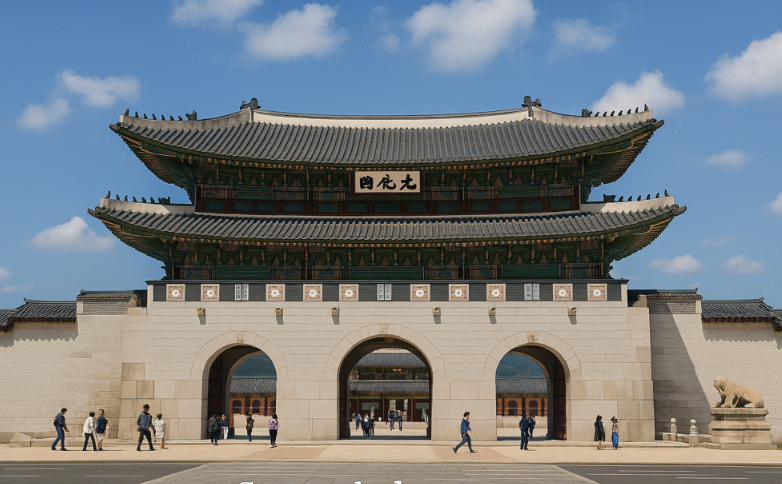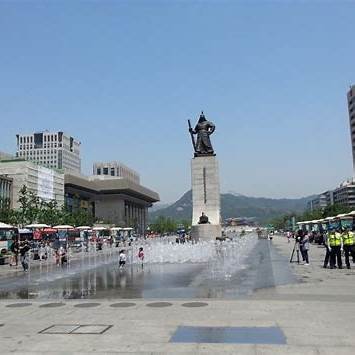If you’re visiting Seoul, Gwanghwamun and Gwanghwamun Square are must-see landmarks that blend Korea’s royal history with its modern identity. Situated at the very center of the city, this iconic area offers visitors a rich mix of historic architecture, cultural events, and breathtaking cityscapes.
1. Gwanghwamun: The Majestic Main Gate of Gyeongbokgung Palace

Gwanghwamun Gate is the grand southern entrance to Gyeongbokgung Palace, the largest of the Five Grand Palaces of the Joseon Dynasty.
- Historical Significance: First built in 1395, the gate has been destroyed and rebuilt multiple times, most recently restored to its original wooden structure in 2010.
- Architecture: Designed in the three-arch style, with the central arch reserved for the king and the side arches for officials and servants.
- Photo Spot: The gate’s backdrop of Bugaksan Mountain makes it one of the most picturesque spots in Seoul, especially during sunrise or sunset.
💡 Tip: Since Gwanghwamun is the main entrance, you can easily walk straight into Gyeongbokgung Palace and explore its grand halls, gardens, and on-site museums right after visiting the square.
2. Gwanghwamun Square: A Cultural Plaza in the City’s Heart

Located directly in front of Gwanghwamun Gate, Gwanghwamun Square is a wide pedestrian-friendly space that serves as a hub for history, culture, and public life.
- Key Monuments:
- King Sejong the Great Statue – Celebrating the inventor of the Korean alphabet, Hangul.
- Admiral Yi Sun-sin Statue – Honouring Korea’s legendary naval hero.
- Public Events: Seasonal flower festivals, cultural exhibitions, and performances are frequently held here.
- Scenic Views: From the square, you can see the perfect alignment of Gwanghwamun Gate, Gyeongbokgung Palace, and Bugaksan Mountain.
3. Activities You Can Enjoy
a. Watch the Royal Guard Changing Ceremony

One of the most photographed cultural events in Seoul, held twice daily (10:00 a.m. & 2:00 p.m., except Tuesdays) right at Gwanghwamun Gate.
b. Take a Historical Walk
Stroll through Gwanghwamun Square, read the history panels, and visit the underground Sejong Story Exhibition Hall for interactive displays.
c. Night Photography
In the evening, both the gate and square are beautifully illuminated, creating a magical atmosphere perfect for night photography.
4. Nearby Attractions
- Cheonggyecheon Stream – Just a short walk from Gwanghwamun Square, this restored urban stream offers a peaceful walking path in the middle of the city.
- Sejong Center for the Performing Arts – A cultural hub hosting concerts, theater performances, and exhibitions.
- Bukchon Hanok Village – Traditional Korean houses located just behind Gyeongbokgung Palace.
5. Travel Tips
- Location: Jongno-gu, Seoul, South Korea
- Subway Access:
- Line 3 – Gyeongbokgung Station, Exit 5 (for the gate)
- Line 5 – Gwanghwamun Station, Exit 2 (for the square)
- Best Time to Visit: Morning for fewer crowds; evening for the best lighting.
- Admission: Gwanghwamun Square is free; Gyeongbokgung Palace requires a ticket (free if wearing hanbok).
Conclusion
Gwanghwamun and Gwanghwamun Square are more than just historic landmarks—they’re living symbols of Korea’s resilience, cultural pride, and artistic spirit. Whether you come for the royal ceremonies, photo opportunities, or peaceful evening strolls, this area will give you a deeper appreciation of Seoul’s unique charm. And with Gyeongbokgung Palace just steps away, your cultural journey can seamlessly continue into the grandeur of Korea’s royal heritage.